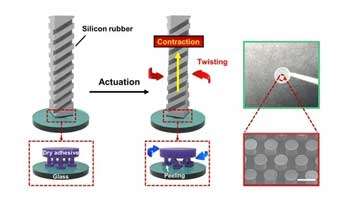 In a novel approach to robotic handling, researchers have successfully developed a technique that allows fragile objects to be delicately transferred and released without any damage. Taking cues from the adhesive capabilities of geckos, a team of researchers from Kyungpook National University and Dong-A University in South Korea has pioneered a robotic device with the potential to revolutionise the way delicate materials are handled by machines. The findings of their groundbreaking research have been published in the esteemed international science journal, Science and Technology of Advanced Materials.
In a novel approach to robotic handling, researchers have successfully developed a technique that allows fragile objects to be delicately transferred and released without any damage. Taking cues from the adhesive capabilities of geckos, a team of researchers from Kyungpook National University and Dong-A University in South Korea has pioneered a robotic device with the potential to revolutionise the way delicate materials are handled by machines. The findings of their groundbreaking research have been published in the esteemed international science journal, Science and Technology of Advanced Materials.
Geckos are renowned for their ability to seemingly defy gravity, clinging effortlessly to walls and navigating across ceilings. The key to their dry but sticky secret lies in the microscopic hairs covering their feet, known as micro setae. These tiny hairs, measuring approximately 100 micrometers in length and 5 micrometers in diameter, branch out into flat triangular pads called spatulae. It is the interaction of these spatulae with the surface that generates weak van der Waals forces, allowing geckos to adhere to various surfaces.
The inspiration drawn from the gecko’s natural adhesive ability has led researchers to explore its application in robotics. While previous attempts utilised artificial dry adhesives mimicking the gecko’s mechanism, challenges arose in detaching these adhesives without causing damage, especially to fragile materials like glass. Seung Hoon Yoo, the first author of the research article, highlighted the necessity for a robotic system not only to pick up objects but also to detach easily, leaving the object undamaged in its desired location.
To address this detachment issue, the research team introduced a vacuum-powered device made of soft silicon rubber. A new detachment method involving a twisting and lifting motion was implemented to pull the dry adhesive off surfaces, minimizing the risk of damage to delicate objects. The researchers observed a remarkable ten-fold reduction in the force required for detachment, a critical factor when handling fragile materials.
In practical tests, the transfer system was attached to a robotic arm, demonstrating its ability to pick up a delicate glass disc from a sloping surface, relocate it, and gently set it down without causing any damage. Sung Ho Lee, one of the study’s authors, expressed optimism about the industry’s interest in dry adhesives for temporary attachment and movement of components, particularly in robotic applications. The research team aims to bridge the gap between academic exploration and industrial application, envisioning broader use and the development of more advanced models in the near future. (Source: Science and Technology of Advanced Materials)
